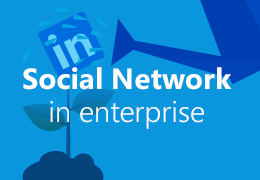


‘Digital collaboration’ can take many forms, and for many years companies and organizations of all shapes and sizes have looked to help their employees work smarter using technology solutions. In the early days of computing and Intranet technology, static ‘magazine’ style systems where the norm. Users consumed information in a fairly basic manner, and almost always ‘one way’ direction.
Where the consumer web goes, the enterprise tends to follow, and the explosion of social networking has made many companies sit up and consider using enterprise social networks (ESN) of their own. These networks can take many forms, and use a variety of products and platforms, but they all tend to follow the same basic premise of enabling rich real time interactions between multiple individuals.
The design and development of enterprise social network software is only part of the story. The other side, often overlooked by many companies wishing to get involved, is how to successfully launch, nurture and grow these systems. In the post we shall look at five key ways to successfully ‘seed’ a social network in your enterprise, and help it grow into a vital business tool.
This tip applies to many IT projects, but is especially relevant to enterprise social networks. When a new system is being developed, get end users involved in the process. Talk to them regularly about their needs, ask them to help out with testing and previews and send them regular updates about launch plans.
Involving users right from the start helps make them feel part of the project. This sort of buy-in and feeling of ownership can feel vital when trying to get an enterprise social network off the ground.
In order to be successful an enterprise social network must embed itself into an employee's daily workflow. It must make their life easier - fading into the background when not needed but useful everyday as part of the person’s day to day job.
The worst thing a social system can do is jar with its users work patterns, get in the way or inhibit their normal activities. Social systems must have a purpose, and one that fits in with an organizations and employees overall aims.
For example many companies send out email newsletters. These can be redesigned and delivered via an enterprise social network. Here they can be consumed in smaller chunks, discussed in context, and more easily disseminated. Moving an existing tool or comms channel over to a social medium in this way helps to embed the new system into company culture.
We looked at this in more detail in a blog post with Alan Lepofsky, a noted analyst and commentator on collaboration software.
Users are more likely to engage with a system that is easy to use, visually appealing, and responsive. One of the reasons tools like Dropbox and email are so popular is that they address all of these points extremely well. Their adoption rates are high because users find them intuitive. If your enterprise social network doesn’t offer the same, or better, then it will struggle.
Gartner, the information technology research and advisory company, go as far as to rate user experience as one of the key factors shaping user engagement with social systems:
“Most organizations do not pay enough attention to usability or the end-user experience when choosing social software. Unintuitive UIs and uninspiring design are all reasons for poor user acceptance.”
Traditionally enterprise software has paid little attention to visual design and interface flair. Yet modern software now mimics and surpasses the cutting edge consumer solutions many users are used to. The enterprise is no longer immune to this type of innovation, and in many cases is leading the way.
An enterprise social network is a business system, and thus needs maintaining from a hardware/software point of view like any other. But it is also a community that needs regular care and attention. Both of these tasks require dedicated resources in order to be correctly addressed.
A common mistake many organizations take is to expect people to maintain an ESN in their spare time or lunch hour. This lack of focus hampers growth. Who is responsible for driving cultural change? Who is responsible for running training courses, or answering user queries?
A dedicated, even part time, resource is a must. Simply having someone specific that users can turn to if they need will greatly increase the chances of your community successfully growing.
Building on point four, an enterprise social network is capable of delivering information, and engaging users, in new and innovative ways. Organizations should look to use social features to hold dedicated events, events that wouldn't be possible in any other way.
For example, hosting regular ‘Ask the CEO’ meetings on the network is a good way to engage users. Just like consumer social networks bring users closer to politicians and popstars, this is a great of way to bring people closer to senior figures in the company. Making the enterprise social network the only tool hosting this kind of thing is a great way to drive adoption.
Driving engagement and adoption
An enterprise social network is, in many ways, like any other business tool. It relies on a combination of good content and great functionality to succeed. Choosing the right platform or product is vital. Involving the whole organization in creating compelling content and interactions is also very important. The five steps listed above should also help seed and nurture a new community. We also wrote a little more about adoption in a previous post - It’s about the adoption, stupid! - that you might also find useful.
One thing is clear, once such a community is in place everyone benefits - from individual employees to the wider company.
Find out how Vodafone successfully built an integrated social network, using Beezy, which helps every employee connect and collaborate with each other.
These Stories on Beezy

No Comments Yet
Let us know what you think